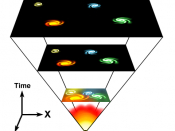The most popular and accepted theory for the origin of the universe is the Big Bang Theory. This theory states that the universe began about 10 billion years ago in a violent explosion; every particle started rushing apart from every other particle in an early super-dense phase. This explosion sent energy and matter flying all over the place. However, there is an argument about whether time and space existed before the big bang, or did the big bang create time and space.
As the universe expanded, according to scientific understanding, matter collected into clouds that began to condense and rotate, forming the forerunners of galaxies. Within galaxies, including our own Milky Way galaxy, changes in pressure caused gas and dust to form distinct clouds. In some of these clouds, where there was sufficient mass and the right forces, gravitational attraction caused the cloud to collapse. If the mass of material in the cloud was sufficiently compressed, nuclear reactions began and a star was born.
Some of the stars, including our sun, formed in the middle of a flattened spinning disk of material. In the case of our sun, the gas and dust within this disk collided and aggregated into small grains, and the grains formed into larger bodies that are actually just very small planets. Some of these minute planets reached diameters of several hundred kilometers. In successive stages these planets joined together into the nine planets and their numerous satellites. The rocky planets, including Earth, were near the sun, and the gaseous planets were in more distant orbits.
Another possible way that the universe was originated was through the will of God. Many religious people, including many scientists, believe that God created the universe along with the various processes driving physical and biological evolution and that these processes...


